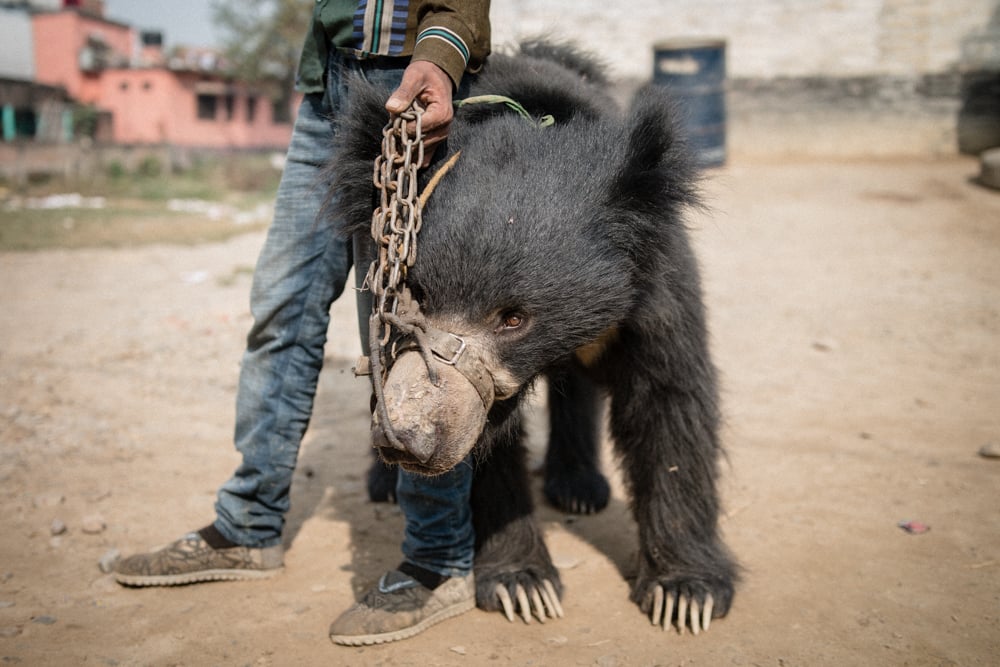Bear sanctuaries
These sites offer large natural habitats and expert care for rescued bears to live out their lives in peace.

Bear dancing is a distressing form of animal abuse where bears are forced to 'dance' for entertainment and profit. Often captured as cubs, these bears undergo severe physical and psychological torment. Their teeth are filed or knocked out, claws removed, and muzzles painfully pierced to attach ropes, all without anesthesia. Trainers use brutal methods such as forcing bears to stand on hot metal sheets, causing them to lift their paws in a painful imitation of dancing. This barbaric 'training' is repeated to the sound of music until bears respond automatically to the painful tug of the rope.
Bear baiting, a severe form of animal abuse, involves defenseless bears being set upon by trained dogs for entertainment. This cruel sport, largely eradicated but still present in rural Pakistan, showcases bears battling against dogs while tied, severely limiting their movement and ability to defend themselves.
Once prevalent in 18th century England, bear baiting now persists primarily in rural Pakistan. Despite being illegal, these practices survive due to weak enforcement, financial incentives for organizers, and limited alternatives for bear owners. These spectacles subject bears to immense physical and psychological torment.
To make them less dangerous to people and less able to defend themselves during baiting events, cubs may undergo horrific mutilations after they are poached from the wild. They may have their canine teeth extracted, broken or filed off with no pain killers or anesthetics. Their claws are ripped out at the root, and a nose ring or ropes are sewn through the young cub’s nose or muzzle causing agonizing pain. They are then sold to be used to beg on the streets or rent them out for bear baiting events.
Many captive bears used in entertainment, such as dancing and baiting, are poached from the wild as cubs. The lifespan of these bears in captivity is significantly reduced, necessitating the continuous poaching of new bears to replace them.
Poaching bear cubs from the wild has profound ecological consequences. Removing these young bears not only reduces the wild population but also disrupts natural ecosystems. The death of mother bears during these poaching incidents further exacerbates the issue, underscoring the need for stringent conservation efforts to protect these majestic creatures and their habitats.
Since 1997, World Animal Protection, in partnership with the Bioresource Research Centre (BRC), has worked relentlessly to end bear entertainment in Pakistan. This partnership involves investigative work, public awareness campaigns, and managing a bear sanctuary.
Achievements in ending bear dancing and baiting:
A critical aspect of our solution is providing bear owners with alternative, cruelty-free livelihoods. This approach includes assisting former bear owners in establishing new businesses like general stores. Signing an irrevocable agreement ensures they don't revert to bear baiting or dancing.
Our campaign has been pivotal in phasing out bear dancing and baiting in Pakistan. While we have reduced our campaign support, we continue to offer financial and technical assistance to BRC, focusing on long-term sustainability and care for rescued bears.
Rescued bears, too traumatized for the wild, find refuge in our sanctuaries. Here, they receive care for the rest of their lives, recovering from the physical and mental scars of their past abuse.
These sites offer large natural habitats and expert care for rescued bears to live out their lives in peace.
Our ongoing commitment includes supporting BRC in managing the sanctuary and securing its future. We aim for a world where bears live free from exploitation and cruelty, and where former bear owners thrive in new, ethical livelihoods. impact
For over 30 years, our donors' generosity has enabled the rescue of hundreds of bears and the transformation of numerous lives, both human and animal. This collaborative effort represents a significant step towards a more humane and compassionate world for animals.
News
For three decades we have worked, alongside partners and with our supporters, to end the suffering of bears.